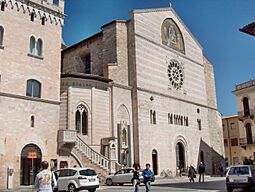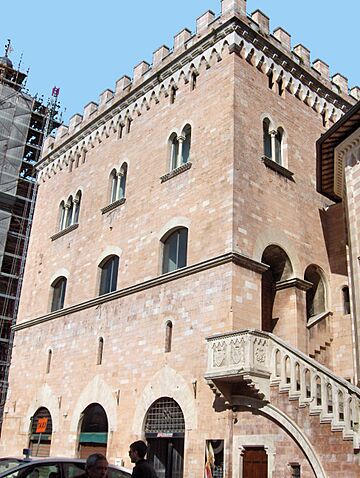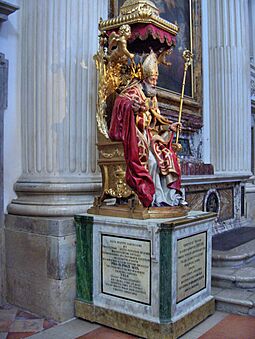Roman Catholic Diocese of Foligno facts for kids
Quick facts for kids Diocese of FolignoDioecesis Fulginatensis |
|
|---|---|

Foligno Cathedral
|
|
| Location | |
| Country | Italy |
| Ecclesiastical province | Perugia-Città della Pieve |
| Statistics | |
| Area | 350 km2 (140 sq mi) |
| Parishes | 39 |
| Information | |
| Denomination | Catholic Church |
| Sui iuris church | Latin Church |
| Rite | Roman Rite |
| Established | 1st century |
| Cathedral | Cattedrale di S. Feliciano V.M. |
| Secular priests | 32 (diocesan) 31 (Religious Orders) 15 Permanent Deacons |
| Current leadership | |
| Pope | Francis |
| Bishop (personal title) | Domenico Sorrentino |
| Website | |
| Diocesi di Foligno | |
The Diocese of Foligno (called Dioecesis Fulginatensis in Latin) is a special area of the Catholic Church in Umbria, Italy. It is led by a bishop and is part of a larger church region. This region is overseen by the Archdiocese of Perugia-Città della Pieve.
Contents
History of the Diocese
People believe that Christianity first came to Foligno around the second century. Saint Felician, who is the patron saint of the city, was an early leader. He was likely not the very first bishop, but he was important. He became a bishop around 193 AD and was martyred (killed for his faith) in 249 AD.
For a long time, not much is known about other bishops until 471 AD. Later, in 523 AD, Vincent of Laodicea became a bishop here.
In 740 AD, a nearby city called Forflamme was destroyed. It is thought that the people living there then became part of the Foligno diocese.
In 1146, an important meeting called a council took place in Foligno. Many bishops and church leaders from different cities attended. During this council, the Foligno Cathedral was officially dedicated. It was named after Saint John the Baptist, Saint Felician, and Saint Fiorenzio.
Cathedral, Churches, and Monasteries
The Foligno Cathedral is a very old church. It was rebuilt starting in 1133. In 1201, a new part was added with beautiful sculptures. The cathedral has a special group of priests called the Chapter. These priests, called Canons, helped the bishop manage the cathedral. Their living area, called the Canonica, existed as early as 1078.
Other important churches in Foligno include Santa Maria infra Portas, which has old Byzantine paintings. There are also San Claudio (built in 1232), San Domenico (built in 1251), and San Giovanni Profiamma (built in 1231).
The Monastery of Sassovivo was founded around 1080. This monastery became very powerful. It eventually controlled many other monasteries and churches. It was famous for its beautiful cloister, which is a covered walkway with 120 columns.
Diocesan Synods: Important Meetings
A diocesan synod was a special meeting held by the bishop of a diocese with his clergy (priests). These meetings were not held regularly, but they were very important. Their main goals were to:
- Announce new rules or decisions made by the bishop.
- Discuss and agree on plans the bishop wanted to make with his priests.
- Share new laws and rules from the diocese, the larger church region, or even the Pope.
One important bishop was Isidoro Chiari (1547–1555). He was a scholar who studied the Bible. He attended the early meetings of the Council of Trent (1545–1547). This was a very important council for the Catholic Church. Bishop Chiari believed that bishops should live in their dioceses and lead their communities directly. He held several synods in Foligno during his time as bishop to discuss church matters.
Other bishops also held synods. For example, Bishop Tommaso Orsini held one in 1571. Bishop Giulio Troili held one in 1703, and Bishop Giosafatte Battistelli held one in 1722. These meetings helped guide the church in Foligno for centuries.
Becoming a Suffragan Diocese
For a long time, the Diocese of Foligno was directly connected to the Pope (the Holy See). This meant it reported straight to Rome.
However, in 1972, Pope Paul VI made a change. This change followed ideas from the Second Vatican Council, which was a major meeting of Catholic leaders. The Pope decided that the Diocese of Perugia would become a Metropolitan Archdiocese. This meant Perugia would be the main diocese in a larger group.
Because of this change, Foligno became a "suffragan" diocese. This means it is now part of the larger church region led by the Archdiocese of Perugia-Città della Pieve. So, instead of reporting directly to the Pope, it now reports to the Archbishop of Perugia.
Bishops of Foligno
A bishop is the main leader of a diocese. They are responsible for guiding the spiritual life of the people in their area.
Early Bishops
- Felicianus (193–249) - The patron saint of Foligno.
- Urbanus (475–498)
- Fortunatus (499–502)
- Vincentius (523–551)
Recent Bishops
- Giovanni Benedetti (1976–1992)
- Arduino Bertoldo (1992–2008)
- Gualtiero Sigismondi (2008–2020)
- Domenico Sorrentino (2021–present)



